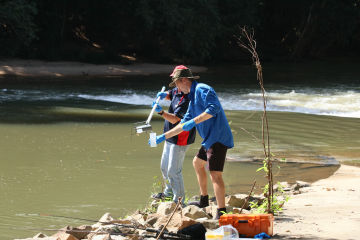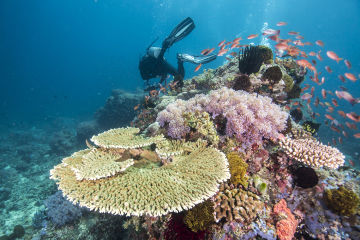Explainers ·
What is reef restoration?
Reef restoration is a broad term for methods used to rebuild damaged coral reefs, so they can maintain healthy, sustainable ecosystems. In other words, it’s all the ways we help the Reef to help itself.

If you’ve ever cleared a section of garden, you might notice that after a few weeks new seedlings and plants will crop up where the old once grew. Reefs are much the same – like any natural ecosystem, reefs erode or degrade over time and then regrow and recover by themselves.
Now, with water temperatures continuing to rise and back-to-back bleaching events becoming increasingly common, our Reef doesn’t have enough time to naturally repair itself. This is where we can help through the process of active restoration – reseeding and regrowing corals to speed up the Reef's natural recovery.

Back-to-back bleaching events means our Reef struggles to recover naturally. Credit: The Ocean Agency
#Why is coral reef restoration important?
Climate change is the biggest threat to our Great Barrier Reef and coral reefs around the world. Their survival depends on the world’s leaders taking drastic and rapid action to reduce global emissions. Yet we know that regardless of this critical work, the warming already locked into the earth's climate system over the coming two to three decades will in itself threaten the ability of reefs to recover.
Our goal is that large-scale, well-designed restoration initiatives can help corals adapt to this changing environment. We know that future reefs will be different to the reefs we have today, but our aim is to ensure that the ecosystem continues to function and remains healthy.
#How to restore reefs
Across the globe, reef restoration practitioners have developed several methods to grow and plant new corals, like tree planting efforts for land ecosystems like forests and bushland.
The techniques are often dependent on the way that corals naturally reproduce. Some coral species can reproduce asexually, forming tiny buds that we can then collect and 'replant'. Others reproduce sexually, in a mass broadcast spawning event. Here, we can collect the sperm and eggs and use them to grow many more babies than would naturally survive.
#1. Coral IVF
During annual coral spawning events, our researchers capture the coral eggs and sperm from healthy reefs to rear millions of baby corals in specially-designed pools on the Reef, and in tanks. They use the pools to encourage fertilisation, before delivering the resulting larvae onto small areas of damaged reefs to repopulate them.
The coral larvae settle onto those reefs and in years to come they will spawn and produce their own coral babies, re-establishing the breeding population of damaged reefs.

Floating coral larval nursery pool set up during spawning.
#2. Coral aquaculture and deployment
Producing large numbers of healthy corals in tanks on land – known as aquaculture - has the potential to change the face of reef conservation, helping to scale-up restoration interventions on the Reef.
The aim is to design and upscale coral aquaculture systems and production pipelines – ensuring end-to-end survival of corals from spawning to settlement and adulthood. The process involves:
- Collect coral fragments and bring them into an aquaculture facility for spawning (reproduction)
- The coral spawn (eggs & sperm) are collected and fertilised, the larvae are reared in nurseries, and then settled onto specially designed surfaces
- Settled corals, or fragments made from the adults, are placed onto devices and placed onto the reef
- Divers revisit the devices to understand where and why they do or don’t survive.
#3. Coral Gardening
Fragments of broken corals or small buds are collected and regrown in land-based or underwater nurseries, before being planted onto reefs – much like you would collect and regrow cuttings or seedlings in a pot, before planting them in your garden.
There are different ways to attach these corals back onto the Reef, including glues or ties. One technique is the Coralclip® which joins corals to the Reef so that the coral can attach and grow, without the need for chemical bonding agents. It is faster and cheaper than traditional out-planting methods and has contributed to an impressive coral survival rate of 85%.

Divers attend to an underwater floating coral nursery. Credit: Coral Nurture
#Reef rubble
When we look to restore the Reef, it’s important we consider the surface on which baby corals will settle. We know it’s often much harder for baby corals to settle and grow on unstable and moving surfaces. Corals that manage to settle on loose rubble pieces can get killed as they tumble around with the waves and the currents. Where rubble forms, the ability of our Reef to naturally recover with each new generation is limited.
As such, restoration efforts can also involve stabilisation – using artificial means like mesh netting or carbonate rocks, or replacing damaged or lost reef with new structures, like specially-designed 3D shapes.
Explainers ·
What is rubble stabilisation?
#Scaling up reef restoration
The science of coral and reef restoration is in its infancy and therefore efforts to date are often small scale and can be expensive.
As part of the Reef Restoration and Adaptation Program, we are investigating the most efficient restoration methods, and harnessing the Reef's natural processes to scale up efforts in cost-effective ways. The Great Barrier Reef contains a huge amount of natural connectivity – we know that just one hundred reefs, if chosen carefully, could supply new baby corals to almost half the Great Barrier Reef.

Our Reef is part of a large system of ocean circulation and currents that circulate and deliver nutrients and larvae from across the Reef and other regions.
We target these reefs for restoration work – including Coral IVF and Coral Aquaculture methods – to help spread populations to reefs that urgently need help. We are also investigating how we can ‘seed’ these reefs with more heat tolerant species, to encourage wide-spread climate resilience. Where possible, we use restoration to help the Reef help itself.
The Reef Restoration and Adaptation Program is the world’s largest effort to help a significant ecosystem survive climate change. Our partners include the Australian Institute of Marine Science, CSIRO, Southern Cross University, James Cook University, QUT and the University of Queensland.

#Tomorrow needs you, now.
The Great Barrier Reef is in desperate need of support. Donate today to help grow new baby corals, creating a better future for the Reef.
#Related

Explainers ·
What is coral spawning?

Explainers ·
Uncovering hidden species with eDNA

Explainers ·
What is biodiversity and why is it so important?

Explainers ·
